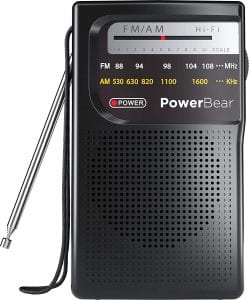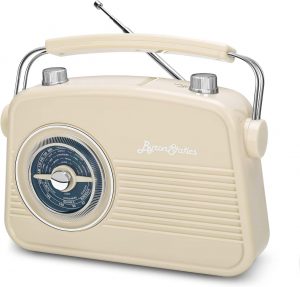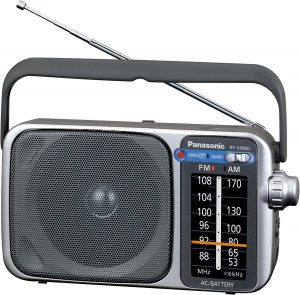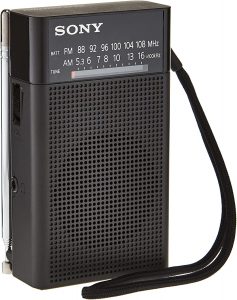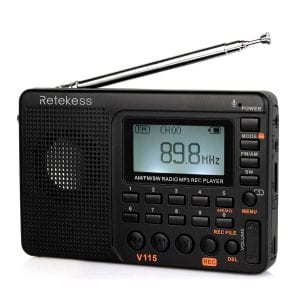The Best AM Radio
We looked at the top 12 AM Radios and dug through the reviews from 93 of the most popular review sites including and more. The result is a ranking of the best AM Radios.
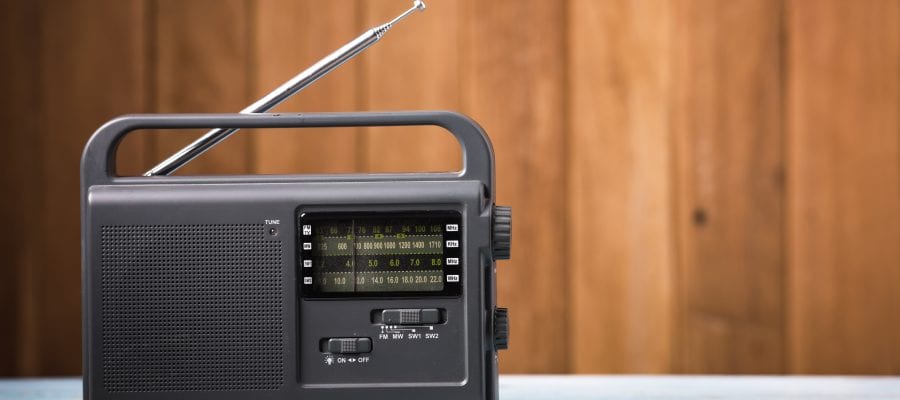
Our Review Process
Don't Waste Your Money is focused on helping you make the best purchasing decision. Our team of experts spends hundreds of hours analyzing, testing, and researching products so you don't have to. Learn more.
Our Picks For The Top AM Radios
Perfect for emergencies, this AM radio is both compact and portable. Not only does it have a long range, but it also runs for 800 hours before needing a new set of batteries. There's even the option of ordering this radio with a black, red or silver finish.
Affordable Price TagWhen shopping on a budget, this economical AM radio is the way to go.
You'll love the retro look of this AM radio, which comes in a lovely cream color. The radio can be powered using four AA batteries or the provided AC power cord. Users will appreciate the large AM/FM knob, which is easy to read, as well as the included earphone jack for more quiet listening.
Blast From the PastThe large handle on this AM radio makes it a cinch to move from one location to another.
This AM radio is rated best value by consumers for its easy-to-use controls and portability. A large speaker projects the sound well across a long distance. The manual dial allows you to get the clearest station possible, unlike a digital analog that skims through stations that don’t come in crystal clear. The weather-resistant case also makes it...
Large SpeakerThe massive speaker on this AM radio projects the sound well, and the manual dial will help to find the clearest stations.
Since this AM radio is small enough to fit in your pocket, it's a good choice when traveling. It has a long telescoping antenna, so you won't have to worry about getting a good reception. It also has an indicator light to let you know when you're batteries are running low.
Handy Indicator LightsThis AM radio has two indicator lights to let you know when the battery is running low and whether you're successfully tuned into the station.
If you're looking for an AM radio with all the bells and whistles, this model is your best bet. It comes with a large digital display screen, a built-in recording microphone and a sleep timer. It also doubles as a clock.
Built-In Recording MicrophoneAlthough this AM radio is battery operated, it also has a USB port and can be used as an MP3 player.
Buying Guide
Although they are often though of as a thing of the past, AM radios are still a valuable asset to have around the house. When the radio was invented, they were a popular luxury to have in your house. They have had a long life and continue to serve a purpose for many people. Perhaps one of the best reasons to keep an AM radio in the house is for live alerts of current happenings. However, before we look at the reasons to have one, let’s talk about how they work.
AM or Amplitude Modulation is a type of radio that utilizes radio waves that are transmitted through the air. Radio waves are a specified length or frequency of electromagnetic waves that are all around us. Each electromagnetic wave has attributed characteristics that are different from each other. Radio waves can reflect, polarize, diffract and refract. They are close to light waves, but our eyes just can’t see them.
Alternating Current (AC) generates electromagnetic waves. This current is used to make all our electronics function. It works at different levels in each country, which is why you may need to travel with a special connector for outlets to use American electronics overseas. In the United States, the AC works with 120 volts at 60 hertz. This basically translates to the current being able to change direction in the wire roughly 60 times per second. Most other countries use 50 hertz. These are considered low-frequency, but still emit a small amount of electromagnetic radiation through the wires into the air. It is often explained as electricity in the air.
As this electricity is given off, it makes unorganized sound. For it to be transmitted as a coherent message, it has to undergo “modulation.” This is where the AM and FM get their names. So, what is modulation? Think of it simply as a change. In order to hear music or voices through the radio, the waves must be changed from their random patterns. The best way to think of it is simply a way of communicating. A quiet mouth tells us nothing, but once it starts to talk, it creates a change that is understandable to the listener. It’s the same with AM radio. The electricity has to be changed into a format that can be understood.
The way this is accomplished is called amplitude modulation. The radio takes the amplitude or height of the signal and transforms it into a single sound. So, for each level of amplitude, a different sound is heard by the listener. The combination of amplitude transformations creates a noticeable pattern either in words or music.
The frequency range that AM transforms is from 520kHz to 1710 kHz in the U.S. Each country has other frequency that their AM and FM radios transmit, so if you travel often, you may be surprised to see music and talk shows coming through at different channel settings.
The reason that AM radio has stayed around for so long is because it can transmit signals over very long distances. The only con to this function is that it allows for more static and noise, particularly when there is inclement weather. It is so sensitive that when lightning gives off electricity, the AM radio will pick up that change in electric activity. In addition to that sensitivity, it only picks up strong signals from 200Hz to 5kHz, making it ideal for talk shows more than music.
Now that you know all about how an AM radio works, let’s look at the different types. If you like to travel with your radio, even if it’s just from room to room in your house, you’ll want to opt for a portable AM radio. Consider a battery-operated model with a digital display feature that has a battery power level indicator. If you prefer to keep the adapter on hand, you can purchase that separately.
For a day at the beach or out on the boat, opt for a radio that features not only a solar panel, but also a hand crank generator that will keep it going in case of a cloudy situation. There is usually a place for batteries as an additional backup, and if all else fails, you can purchase an adapter separately for listening while in the house.
When AM radios first came out, they required an analog tuner and antenna for getting the best reception. The Panasonic has radios that work similarly, making them as retro as you can get. With an extension antenna and a manual knob for selecting your station, this type of AM radio will take you back in time. It can be powered by batteries or an adaptor, depending on where you’d like to use it.
When you want an AM radio specifically for severe weather alerts or emergency protocols, choose a model that has audible hazard alerts and a choice of English, Spanish or Chinese. A digital display that is big and bright with buttons that are very well-marked is also helpful. Finally, a large extension antenna for the best reception is a must.
Why we recommend these am radios?
Products Considered
Products Analyzed
Expert Reviews Included
User Opinions Analyzed
The Best Bang For Your Buck
Sony ICFP26 Built-In Speaker Portable AM Radio
Key Takeawy
Since this AM radio is small enough to fit in your pocket, it's a good choice when traveling. It has a long telescoping antenna, so you won't have to worry about getting a good reception. It also has an indicator light to let you know when you're batteries are running low.
What to Look For
- If you will be using your AM radio for specific talk shows, it might be best to purchase an analog radio. With an analog radio, you can manually adjust the tuning to get a better reception than with a digital that doesn’t always find the frequencies clear enough.
- A few tips for getting a radio program to come in clear are to turn your treble to the lowest setting and your bass to the highest setting. The tone can also be turned all the way down, and in combination, this can bring in a much clearer talk show.
- Your AM radio will usually get the best reception when placed near a window. One exception: If it is placed in a window that is near a power line, then you may pick up interference.
- Using a small type of marker to track where the best reception is on the dial can help you the next time you want to find that station.
- The orientation of your antenna is another way to get your AM radio to function at its best. The AM radio antenna is a rod with a small wire that should work best when aligned with the signal from the broadcast tower. It is not the telescoping rod, which is for FM Radio.
- The worst interference occurs when your radio is within a foot or two of the source of interference. For example, if your AM radio is near a florescent light, television or even a cell phone charger, it will have more interference than normal.
- Some sources of interference cannot be avoided or shut off, such as hard-wired smoke detectors, aquarium heaters, motion sensor lights and even a faulty electrical switch within your home.
- Remember that AM radios dated before 1991 will not have the extended range of frequencies that an AM radio has post-1991, when the FCC added an extension of frequencies from 1605 to 1705 on the dial.
- A digital AM radio is ideal if you need to be doing other things while the talk show is broadcast. So if you are across the room from the radio, you can just use the remote to scan through the other stations.
You May Also Enjoy Our Other Reviews
- Robotic Vacuum
- Cordless Vacuums
- Air Mattress
- Drone
- Electric Razor
- Convertible Car Seat
- Infant Car Seat
- Dry Dog Food
- Carpet Cleaners
- Air Fryers
- Laptops
- Home Printers
- Wireless Router
- Streaming Device
- Electric Pressure Cooker
- Chromebook
- Television
- Digital Camera To Capture Special Moments On The Fly
- Smartwatch
- Upright Vacuum


